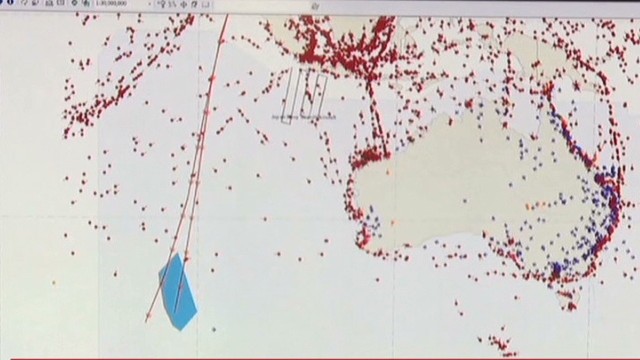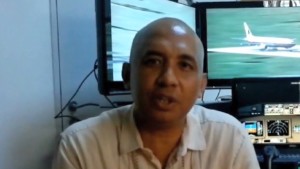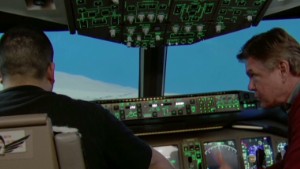
Thailand radar picked up unknown signal
STORY HIGHLIGHTS
- Thai data is the second radar evidence that the plane turned toward the Strait of Malacca
- The total search area now stands at 2.24 million square nautical miles
- The New York Times reports the plane's course change was made by computer
- Background checks turn up nothing on Chinese passengers, Beijing says
The Thai military was
receiving normal flight path and communication data from the Boeing
777-200 on its planned March 8 route from Kuala Lumpur to Beijing until
1:22 a.m., when it disappeared from its radar.
Six minutes later, the
Thai military detected an unknown signal, a Royal Thai Air Force
spokesman told CNN. This unknown aircraft, possibly Flight 370, was
heading the opposite direction.
Malaysia says the
evidence gathered so far suggests the plane was deliberately flown off
course, turning west and traveling back over the Malay Peninsula and out
into the Indian Ocean.
 Police search pilots' homes
Police search pilots' homes
 Partner: I have to prepare for worst
Partner: I have to prepare for worst
 Did plane drop 5,000 ft. to avoid radar?
Did plane drop 5,000 ft. to avoid radar?
But investigators don't
know who was at the controls or why whoever it was took the plane far
away from its original destination.
The Thai data is the second radar evidence that the plane did indeed turn around toward the Strait of Malacca.
It follows information
from the Malaysian Air Force that its military radar tracked the plane
as it passed over the small island of Pulau Perak in the Strait of
Malacca.
"The unknown aircraft's
signal was sending out intermittently, on and off, and on and off," the
spokesman said. The Thai military lost the unknown aircraft's signal
because of the limits of its military radar, he said.
The radar data is an
encouraging sign that investigators are on the right track, but they
still are not sure where the plane ended up.
The latest findings say
the plane's last known location detected by a satellite is somewhere
along two wide arcs: one stretching north over Asia and the other south
into the Indian Ocean. The plane's last electronic connection with the
satellite was about six hours after it last showed up on Malaysian
military radar.
The total area now being
searched stands at 2.24 million square nautical miles, Hishammuddin
Hussein, the Malaysian defense and transport minister, said at a news
conference Tuesday. That's the same as 2.97 million square miles, or an
area nearly the size of the continental United States.
"This is an enormous
search area," Hishammuddin said. "And it is something that Malaysia
cannot possibly search on its own. I am therefore very pleased that so
many countries have come forward to offer assistance and support to the
search and rescue operation."
China clears citizens

 Photos: The search for Malaysia Airlines Flight 370
Photos: The search for Malaysia Airlines Flight 370
 Families wait for word of missing flight
Families wait for word of missing flight
China says it has found no evidence that any of its citizens on board the missing plane were involved in hijacking or terrorism.
Background checks on all
passengers from the Chinese mainland on the plane have found nothing to
support such suspicions, Huang Huikang, the Chinese ambassador to
Malaysia, said Tuesday, according to the state-run Chinese news agency
Xinhua.
Authorities have said they are investigating all 239 people who were on board the flight, which disappeared more than 10 days ago.
According to the airline, 153 of the 227 passengers on board the plane came from mainland China or Hong Kong.
By effectively ruling
out suspicions for a large majority of the passengers, Chinese
authorities appear to have significantly shortened the list of possible
suspects in the investigation.
The Chinese ambassador's
statement is also likely to greatly dampen speculation that Uyghur
separatists from China's far western region of Xinjiang might have been
involved in the plane's disappearance.
One of the two long
corridors where authorities say the plane was last detected stretched
over Xinjiang, and unconfirmed reports had suggested the possibility
that Uyghurs might be connected to the case.
Chinese authorities have
accused separatists from Xinjiang of carrying out a terrorist attack
this month in which eight attackers armed with long knives stormed a
train station in Kunming, a city in southwestern China, killing 29
people and wounding more than 140.
China said Tuesday that
it had begun to search for the plane in the parts of its territory that
fall under the northern corridor, deploying satellite and radar
resources.
 Homes of pilot, co-pilot searched
Homes of pilot, co-pilot searched
 Tracking Malaysia Air flight 370
Tracking Malaysia Air flight 370
 Did plane drop 5,000 ft. to avoid radar?
Did plane drop 5,000 ft. to avoid radar?
Experts are analyzing
past and present data along the arc stretching through Chinese
territory, Hong Lei, a Foreign Ministry spokesman, said at a news
briefing Tuesday in Beijing.
Turn made by computer?
The pilot and first
officer of the missing plane, both of them Malaysian, have come under
particular scrutiny in the search for clues. Investigators say that
whoever flew the plane off course for hours appeared to know what they
were doing.
But officials have so far reported no evidence to tie the pilot and first officer to the plane's disappearance.
Supporting the case that whoever took the plane off course had considerable aviation expertise, The New York Times reported
that the aircraft's first turn to the west was carried out through a
computer system that was most likely programmed by somebody in the
cockpit.
An aviation expert, writing an op-ed for CNN.com, floated the idea last week that whoever changed the plane's course was an expert.
The person who
programmed the change of course would have been somebody "knowledgeable
about airplane systems," The Times reported, citing unidentified
American officials.
The information has
increased investigators' focus on the pilot and first officer, the
newspaper reported. CNN wasn't immediately able to confirm the report.
Asked about the report
Tuesday, Malaysia Airlines Chief Executive Ahmad Jauhari Yahya said: "As
far as we're concerned, the aircraft was programmed to fly to Beijing.
That's the standard procedure."
But he didn't rule out the possibility the flight path had been reprogrammed.
"Once you're in the aircraft, anything is possible," he said.
No comments:
Post a Comment